|
Alpa Reflex modèle 6b |
Manufactured or assembled in Swiss from 1959 to 1960.
Index of rarity in France: Rare (among non-specialized garage sales)
Inventory number: 10360
See the complete technical specifications
Chronology of cameras Alpa
The Swiss company Pignons SA was founded in 1918 and specialized in producing mechanical parts used in watchmaking. Like many companies, diversification became necessary to offset market fluctuations and shortages. Pignons SA decided to venture into the field of photography.
The first camera prototypes were manufactured in 1939 under the brand name BOLSEY, among others.
The history of Alpa Reflex cameras spans over four decades, during which the models underwent significant evolution. Production is generally divided into four generations.
The first generation covers the period from 1942 to 1952. The models are named Standard, Reflex, or Prisma Reflex, and they were made of sheet metal. The Reflex and Prisma Reflex models had both a reflex viewfinder and a rangefinder viewfinder, with the reflex viewfinder mainly used for framing as it was not very precise. Its mirror had to be manually operated. The reflex viewfinder (chest viewfinder) was protected by a metal cover that also served as a sunshade when opened. The name Alpa-Reflex was engraved on this cover. The presence of three windows on the front easily identifies these models. The rangefinder viewfinder was effective for focal lengths up to 135mm. In the Prisma Reflex models, the reflex viewfinder was replaced by a black rectifying prism, and the viewfinder was at eye level. The models referred to as "Standard" did not have the reflex viewfinder.

In 1947, Pignons S.A. applied for a patent for a camera that had both a reflex viewfinder and a rangefinder (Patent No. 260,595). The rangefinder was positioned vertically, and the patent explained that this was the right solution because the upper part was occupied by the reflex system components. This principle would be found in the Model 7.
Cameras of the second generation (1952-1968) were now made from cast metal. They had discontinued the rangefinder viewfinder (except for the Model 7). In addition to the reflex viewfinder, they featured a direct viewfinder. The reflex viewfinder's mirror movement was automatic. The model and serial number were engraved on a small plate at the base of the prism. The early models were called Alpa Alnéa before becoming Alpa Reflex.
The appearance of third-generation cameras (from 1968 onwards) was significantly different, with a more modern silhouette. The prism cover had a flatter, wider shape and incorporated an exposure metering system behind the lens. They had a film winding lever that operated backward, which was different from the usual forward operation found in most cameras.
The fourth generation was the last one entirely manufactured by Pignons in Switzerland. The overall shape resembled other SLR reflex cameras from the 1970s and 1980s. The prism was laterally symmetrical. However, the film winding lever remained reversed from the common practice. The flash shoe was not located on the prism but on one of the two side plates.
Classifying Alpa models is complex, as is dating them. Reference authors sometimes disagree on the details.
| Years (c.) | |||
| First generation | |||
| Bolca-Reflex | 1933-40 | ||
| Reflex model B | 1941-43 | ||
| Reflex model C |  |
1944-46 | |
| Reflex model D | 1945-47 | ||
| Reflex model E |  |
1945-52 | |
| Standard | 1940-52 | No reflex viewfinder | |
| Prisma Reflex E |  |
1950-52 | Rectifying prism |
| Second generation | |||
| Alnea/Reflex model 4 | 1952-89 | No Rectifying prism, Viewfinder through a cap | |
| Alnea/Reflex model 5 |  |
1952-88 | Full rectification. Eyepiece tilted at 45 degrees |
| Alnea/Reflex model 5a |  |
1955-58 | idem with self timer |
| Reflex model 5b | 1959-60 | Idem with rapid mirror | |
| Alnea/Reflex model 6 |  |
1952-78 | Stigmometer |
| Alnea/Reflex model 6b |  |
1959-60 | Idem with rapid mirror |
| Alnea/Reflex model 7 |  |
1952-59 | Prism and coupled vertical rangefinder. |
| Reflex model 8 | 1952-59 | Idem, with Stigmometer | |
| Reflex model 8b | 1959-88 | Idem with winding lever | |
| Third generation : Integrated light meter | |||
| Reflex model 6c |  |
1960- | Integrated light meter |
| Reflex model 9d |  |
1964-88 | TTL |
| Reflex model 9 f |  |
1964-88 | Without light meter |
| Fourth generation : Modernized appearance | |||
| Model 10d |  |
1968-66 | |
| Model 10s | 1973-75 | A model less elaborate than the 10d. | |
| Model 11e |  |
1970- | Exposure indication with diodes of different colors. No indication in the case of correct exposure. |
| Model 11el | 1972-78 | Exposure indication with diodes of different colors. Green light in case of good exposure | |
| Model 11s | 1973-82 | No exposure metering system. | |
| Model 11si | 1978-90 | Silicon light meter | |
Alpa continued to produce in Switzerland until 1976/77, after which production was transferred to Japan. Pignons S.A. eventually ceased its operations in 1991.
The Alpa 6b appeared in 1959. It is part of the second generation of these cameras made in Switzerland by the firm Pignons S.A.
It is the first in that family to receive a rapid return mirror. One characteristic common to all Alpa models up to the 6c (1060) is the 45º finder. It still has a Galilean type finder covering the field of view of 50 mm lenses (the first models Alpa Prisma Reflex had in addition to the reflex finder a rangefinder).
The focal plane shutter, with fabric curtains, offers “B” and speeds from 1 second to 1/1000th. Flash synch at 1/60th. The shutter release button is placed on the front of the body to the right of the lens. Its mounting has a strong shoulder traversed by a button (part of the lens’ barrel) that presses the shutter release (on the body) and that itself operates a mechanism that stops the lens down to a preselected aperture. The little knurled knob, marked with an arrow and visible on the top of the shoulder, closes the diaphragm manually to allow depth of field preview.
Film advance/shutter cocking of earlier models was done with a large knurled knob; shutter speed was selected by raising the knob’s outer ring. This knob is retained here, but is topped off by a robust lever which has the peculiarity of having to be operated in a counter-clockwise direction (this is opposite to the direction of most other cameras).
The Alpa 6b has a self-timer (chromed lever to the right of the lens, and below the shutter release button).
Lenses and accessories
The camera shown is fitted with a 50/1.8 Kern MacroSwitar, allowing focusing to 28 mm from the subject (magnification 1:3).
The closeup photo of the lens shows the lens’ depth of field scale. While turning the diaphragm ring, one moves a colored (copper) section under some small holes drilled in the lens’ barrel. The holes’ positions correspond to the limits of depth of field for each aperture, which is read on the focusing ring’s scale. The distance scale is in meters and in magnification ratio – red engraving (remember that this is a macro lens). Here, the diaphragm being set to f/8 and focused distance set to 1.10 m, the depth of field extends from 1.00 m to 1.20 m (a depth of field calculation gives, with more precision, 1.00 m to 1.22 m). [translator’s comment: this style of depth of field scale is also used on Switar cine lenses.]
A large range of lenses is available, from the best makers of the time: Angénieux, Kilfitt, Schneider, Kinoptic, as well as all of the usual accessories, extension tubes, and bellows. The bayonet mount is proprietary as is the mounting (spring-loaded) of filters and lens shades, the front of the lenses are not threaded.

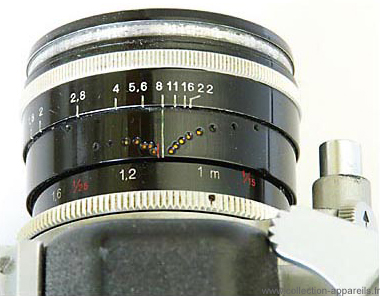
Interesting links or bibliography :
Add a link or element of bibliography, a picture taken with this camera, a picture of box or an ads about this camera
Your photos taken with the same camera:
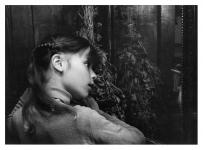
| 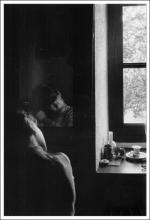
| 
| 
| 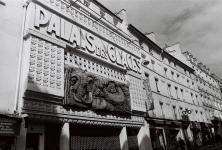
| 
| 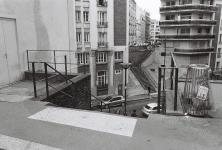
| 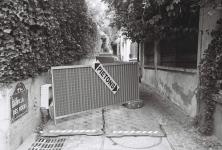
|
Cameras from Ebay France (Alpa) (Uploaded each 3 hours)







